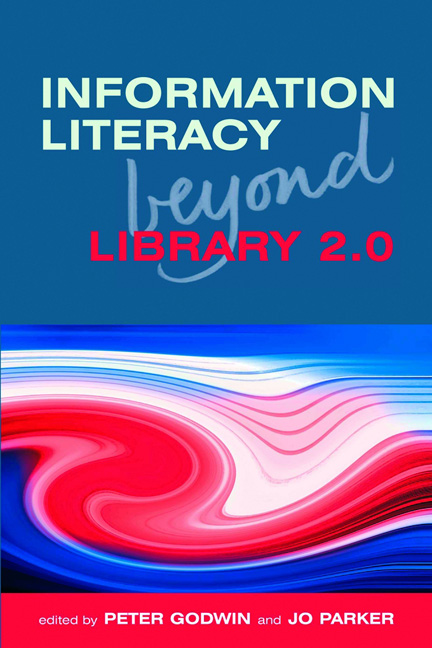Book contents
- Frontmatter
- Contents
- Contributors
- Acknowledgements
- Introduction
- PART 1 RECENT DEVELOPMENTS IN INFORMATION LITERACY AND LIBRARY 2.0
- 1 Library 2.0: a retrospective
- 2 Information literacy and Library 2.0: an update
- 3 The story so far: progress in Web 2.0 and information literacy
- 4 The changing web: sites to social
- 5 Web 2.0: from information literacy to transliteracy
- 6 Informed learning in online environments: supporting the higher education curriculum beyond Web 2.0
- PART 2 CASE STUDIES
- PART 3 WHAT IT MEANS FOR INFORMATION PROFESSIONALS
- Index
3 - The story so far: progress in Web 2.0 and information literacy
from PART 1 - RECENT DEVELOPMENTS IN INFORMATION LITERACY AND LIBRARY 2.0
Published online by Cambridge University Press: 09 June 2018
- Frontmatter
- Contents
- Contributors
- Acknowledgements
- Introduction
- PART 1 RECENT DEVELOPMENTS IN INFORMATION LITERACY AND LIBRARY 2.0
- 1 Library 2.0: a retrospective
- 2 Information literacy and Library 2.0: an update
- 3 The story so far: progress in Web 2.0 and information literacy
- 4 The changing web: sites to social
- 5 Web 2.0: from information literacy to transliteracy
- 6 Informed learning in online environments: supporting the higher education curriculum beyond Web 2.0
- PART 2 CASE STUDIES
- PART 3 WHAT IT MEANS FOR INFORMATION PROFESSIONALS
- Index
Summary
I have delivered many presentations suggesting that the IL and Web 2.0 connection might be overplayed (Godwin, 2009a). How much evidence is there that libraries and librarians are really viewing the information landscape as different, requiring Web 2.0 to be included and used to teach IL? How much impact is it having on student learning?
Luo (2010) conducted a survey of IL instruction librarians who were members of the Information Literacy Instruction Discussion List sponsored by the Association of College and Research Libraries. Fifty valid responses were received, which were then followed up by eight interviews which revealed some great ideas of how librarians have employed blogs, wikis, social bookmarking sites, YouTube and Flickr. Luo separates his respondents into those who use Web 2.0 for their own purposes, those who use them for facilitating delivery of IL to students and those who use the facilities of certain Web 2.0 tools to enhance the teaching of specific aspects of IL. An example of the latter was where the respondent had used Flickr to get the students to collect some digital images and apply attribution, in order to explain Creative Commons, and then doing a similar exercise with Wikipedia. Luo concludes that ‘it is indisputable that Web 2.0 is becoming more and more prevalent and its value to facilitating IL instruction is recognized’ (Luo, 2010, 39), but more research is needed, particularly around assessing how the students react to it and how it affects learning outcomes. There is still a feeling that students regard social media as their own province and resent their use for academic purposes.
It is possible to get some clues regarding take-up from Tripathi (2009), who surveyed university libraries: 82 in the UK, 151 in the USA, 37 in Canada and 7 in Australia. Of the 45% that had blogs, 20.53% used them for search tips and 8.53% for IL. Most of the 11% that used podcasts and the 6% that used vodcasts did so for some IL purpose. Tripathi also notes that the 300 University Grants Commission-recognized universities in India had yet to start using Web 2.0 tools. In the Philippines, Lapuz (2009) enthusiastically and successfully championed their use in library schools, but found school teacher-librarians much less receptive.
- Type
- Chapter
- Information
- Information Literacy Beyond Library 2.0 , pp. 27 - 40Publisher: FacetPrint publication year: 2012



